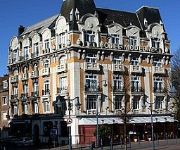Facts and Data
Webpages:
Official Unesco Page
www.sites-vauban.org
Basis Data:
Unesco World heritage since: 2008
Size of heritage: 1,153 ha
- Buffer zone: 4,341 ha
Coordinates:
Longitude: 2,759°
Latitude: 50,283°
Summary
Fortifications of Vauban consists of 12 groups of fortified buildings and sites along the western, northern and eastern borders of France. They represent the finest examples of the work of Sébastien Le Prestre de Vauban (1633-1707), a military engineer of King Louis XIV. The serial property includes towns built from scratch by Vauban, citadels, urban bastion walls and bastion towers. There are also mountain forts, sea forts, a mountain battery and two mountain communication structures. This property is inscribed as bearing witness to the peak of classic fortifications, typical of western military architecture. Vauban also played a major role in the history of fortification in Europe and on other continents until the mid-19th century.
Location on Map
Show bigger map on Openstreetmap
Fortifications of Vauban
The Fortifications of Vauban, located in France, are a UNESCO World Heritage site that encompasses a series of fortified structures designed by the renowned military engineer Sébastien Le Prestre de Vauban. These fortifications played a crucial role in the defense of France during the 17th and 18th centuries and are considered masterpieces of military architecture.
History
The construction of the fortifications began in the late 17th century under the reign of King Louis XIV, who appointed Vauban as his chief military engineer. Vauban's innovative designs revolutionized the field of fortification, incorporating both practical and aesthetic elements. Over the course of his career, Vauban designed and fortified over 300 sites across France, including cities, ports, and mountain passes.
The Fortifications of Vauban were strategically located along France's borders, protecting key cities and regions from potential invasions. These fortresses were designed to withstand artillery attacks and siege warfare, featuring bastions, moats, and underground tunnels. Vauban's designs also took into account the natural landscape, incorporating hills, rivers, and cliffs to enhance the defensive capabilities of the fortifications.
During the 18th century, the fortifications underwent further expansions and modifications to adapt to changing military strategies and technologies. However, with the advent of modern warfare and the decline of the importance of fortifications, many of Vauban's structures fell into disuse and disrepair.
Current State
Today, the Fortifications of Vauban are recognized as a UNESCO World Heritage site, highlighting their historical and architectural significance. The site includes twelve major fortresses spread across France, including the Citadel of Besançon, the Fortifications of Briançon, and the Fort of Saint-Nicolas in Marseille.
Efforts have been made to preserve and restore these fortifications, ensuring their cultural and historical value is safeguarded for future generations. Many of the sites have been transformed into museums, allowing visitors to explore the intricate network of tunnels, barracks, and defensive structures.
The Fortifications of Vauban not only serve as a testament to Vauban's engineering genius but also provide insights into the military strategies and technologies of the time. The sites offer a unique opportunity to understand the challenges faced by past generations in defending their territories.
Furthermore, the fortifications are often surrounded by stunning natural landscapes, adding to their allure. Visitors can enjoy panoramic views of mountains, rivers, and valleys while exploring the fortresses.
The Fortifications of Vauban are not only of historical and architectural importance but also contribute to the cultural identity of France. They serve as a reminder of the country's rich military heritage and the ingenuity of its engineers and architects.
Overall, the Fortifications of Vauban are a remarkable UNESCO World Heritage site that showcases the brilliance of Sébastien Le Prestre de Vauban's military architecture. They provide a glimpse into France's past and offer visitors a chance to appreciate the country's cultural and historical legacy.
Hotels and places to stay
Najeti Hôtel de l'Univers
Hôtel Mercure Arras Centre Gare
ibis Arras Centre Les Places
Holiday Inn Express ARRAS
Hôtel Moderne
Campanile - Arras Saint-Nicolas
Hôtel Diamant
Hôtel Les Trois Luppars
La Belle Etoile
Première Classe Arras – Saint-Laurent-Blangy – Parc Expo
Videos from the area
Videos provided by Youtube are under the copyright of their owners.

















